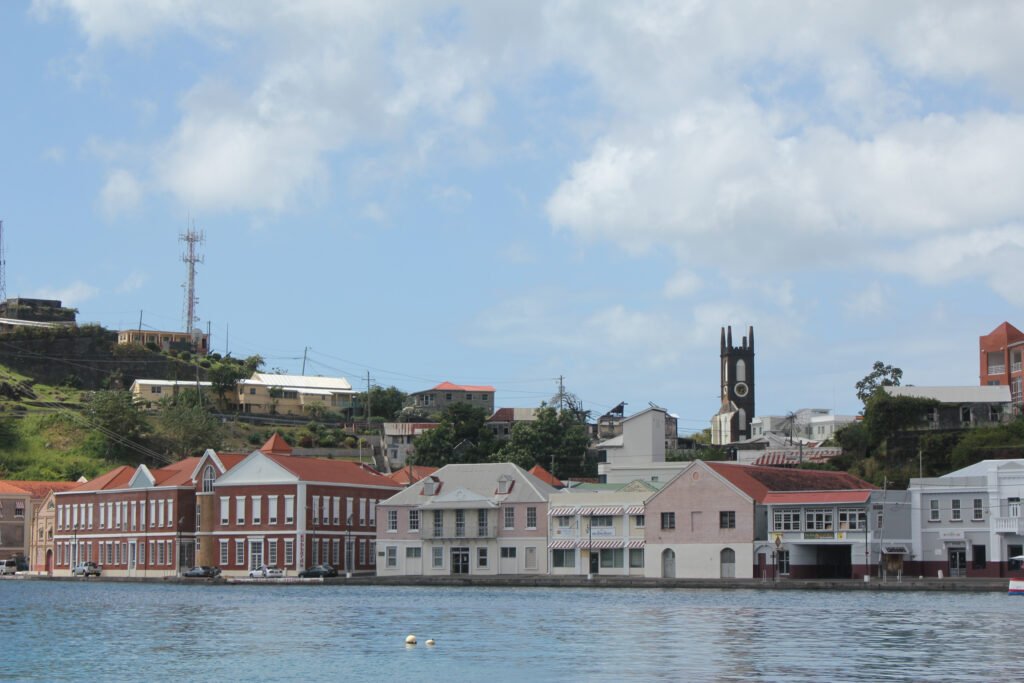
Your journey into Grenada’s culinary heart start at St. George’s Market. The air is filled with the scent of nutmeg and tropical fruit. Here, you’ll see that Grenada is more than a place—it’s a feast for the senses.
Grenada is known as the Spice Isle, and it’s not just a nickname. It’s a promise of flavors steeped in history and skill. The island’s food mixes French Créole, African, and Indian styles, making dishes both familiar and unique.
The island’s chocolate plantations, like Belmont Estate, tell stories of old trade routes. Street vendors in St. George’s serve callaloo soup that tastes like sunshine. Every bite here connects to centuries of tradition.
Walking through cocoa groves and tasting nutmeg from seeds, you’ll get to understand why UNESCO named Grenada a Creative City of Gastronomy. This island is for those who love to explore Caribbean culinary experiences. It’s a place that feeds both curiosity and the soul.
Key Takeaways
- Grenada’s St. George’s Market is the heartbeat of Grenada food tourism, offering fresh spices and local delicacies.
- Chocolate tours at historic plantations highlight Grenada’s role as a premier Caribbean cocoa producer.
- Grenadian gastronomy merges global flavors into dishes like oil down, a national treasure.
- UNESCO’s recognition underscores Grenada’s status as a must-visit for serious food enthusiasts.
- Exploring spice plantations and rum distilleries reveals the island’s rich culinary heritage.
The Spice Isle: Why Grenada Should Be Your Next Culinary Travel Destination
Exploring Grenada’s culinary scene is like opening a jar of fresh nutmeg. You’ll smell history and innovation. This Caribbean island is known as the Grenada spice island. It mixes flavors from centuries of cultural exchange. Each dish shares a story of resilience and creativity.
The Rich Culinary Heritage of Grenada
In village markets, you get to see Grenadian culinary heritage alive. African callaloo stews meet French Créole sauces and indigenous spice-drying techniques are passed down in family recipes. This mix makes Grenada’s food a living museum of migration and adaptation.
How Grenada Earned Its Nickname “The Spice Isle”
Imagine walking through a landscape filled with cinnamon and allspice scents. Nutmeg is the star here, with Grenada producing over 20% of the world’s supply.
influences global spice markets. Here’s a look at some key spices:
| Spice | Iconic Use | Local Name |
|---|---|---|
| Nutmeg | Seasoning oil down rice dishes | “Mace and magic” |
| Chocolate | Belmont Estate’s award-winning bars | “Liquid gold” |
| Bay leaves | Essential in fish soups | “Island’s green confetti” |
UNESCO Creative City of Gastronomy Recognition
In 2023, Grenada became a UNESCO gastronomy city. This recognition protects traditions like “oildown” cooking. It also encourages chefs to create new dishes with local ingredients.
Every bite here connects the past and present. From sun-dried spices to UNESCO-recognized innovation, Grenada’s table is a journey to the heart of the Grenada spice island.
Planning Your Culinary Travel to Grenada: Best Time to Visit and Duration
Deciding when to visit Grenada depends on the weather and food events. December to April is the best time, with cool breezes and lively markets. But, prices go up during this time.
For a peaceful trip, consider May-June or November. These months offer green landscapes and fewer people. They’re great for enjoying the Grenada food festivals, like the Chocolate Festival in May.
Festivals are a big part of Grenada’s charm. The August Spice Mas carnival is filled with street food. Fish Friday in Gouyave is a feast of fresh seafood.
Don’t miss Belmont Estate’s cocoa tours. They offer a complete taste experience. A 7–10 day trip lets you explore deeply.
| Duration | Experience |
|---|---|
| 4 days | City highlights & signature dishes |
| 7 days | Plantation tours + festival attendance |
| 10+ days | Full immersion: cooking classes, rum distillery visits, and remote village meals |
Get a local driver to show you secret spots. Stay at places like Ladera for amazing views and meals. Be flexible, as Grenada’s beauty is in its unexpected moments.
St. George’s Market: The Epicenter of Grenadian Food Culture
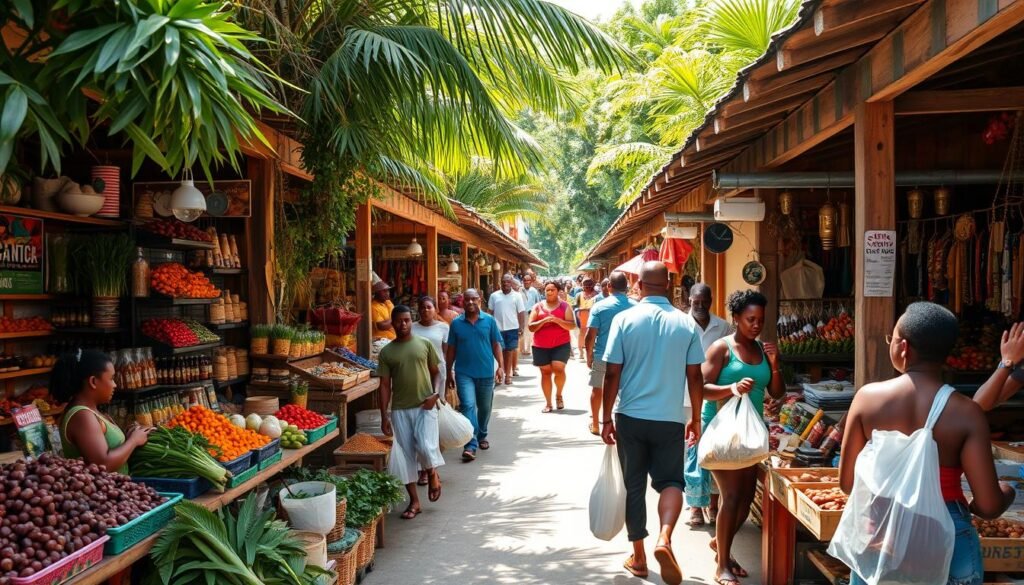
St. George’s Market is a vibrant showcase of Grenada’s flavors. The sun shines through the tin roof, lighting up baskets of Grenada fresh market delights. The air buzzes with conversations and the smell of nutmeg.
Vendors carefully arrange Grenadian spice market treasures. This place is where the island’s heart beats in every spice and herb.
Navigating the Market Like a Local
Locals arrive by 7 AM on Saturdays for the best local market shopping Grenada experience. Here’s how to navigate:

- Start at the fish section, where mackerel and ackee fruit shine.
- Ask for “how you do” prices; vendors love a good haggle.
- Explore the spice aisles last; their scent lingers on your tongue.
Must-Try Fresh Produce and Spices
Here’s what to look for in the stalls:
| Product | Description | Where to Find |
|---|---|---|
| Golden Callaloo | Tender greens used in oil down stews | Vegetable stalls near the entrance |
| Soursop | Sweet-tart fruit used in refreshing drinks | Fruit vendors under the northern canopy |
| Whole Nutmeg | Still in crimson husks, ready for grinding | Miss Josephine’s stall (third from the spice section) |
Meeting the Vendors: Stories Behind the Food
“My grandfather’s hands planted these trees,” says Thomas, pouring a cup of sorrel tea infused with wild herbs. His family’s stall preserves remedies passed through generations.
Miss Josephine’s nutmeg display tells a century-old tale. “Every spice here grows within 10 miles,” she says, wrapping dried ginger in banana leaves. These vendors are more than sellers; they’re keepers of tradition.
Chocolate Paradise: Touring Grenada’s Historic Cocoa Plantations
Imagine tasting chocolate so pure it feels like the earth itself. This is what Grenada’s cocoa plantations offer. Start your journey at Belmont Estate Grenada, where ancient cacao trees share tales of survival. This 300-year-old estate, set in green hills, shows how hurricanes and rebirth created a new story.
The guides show you how they turn sun-dried beans into smooth bars. This journey turned post-Ivan scarcity into a celebration of old ways.
Belmont Estate: Bean-to-Bar Chocolate Experience
At Belmont Estate Grenada, farmers are seen handling cocoa pods like ancient rituals. Their bean to bar chocolate Grenada journey begins here. Beans ferment under banana leaves, soaking up tropical air.
Tasting truffles made from estate-grown Criollo beans, you notice why this chocolate is overly prized. It’s now found on Michelin menus.
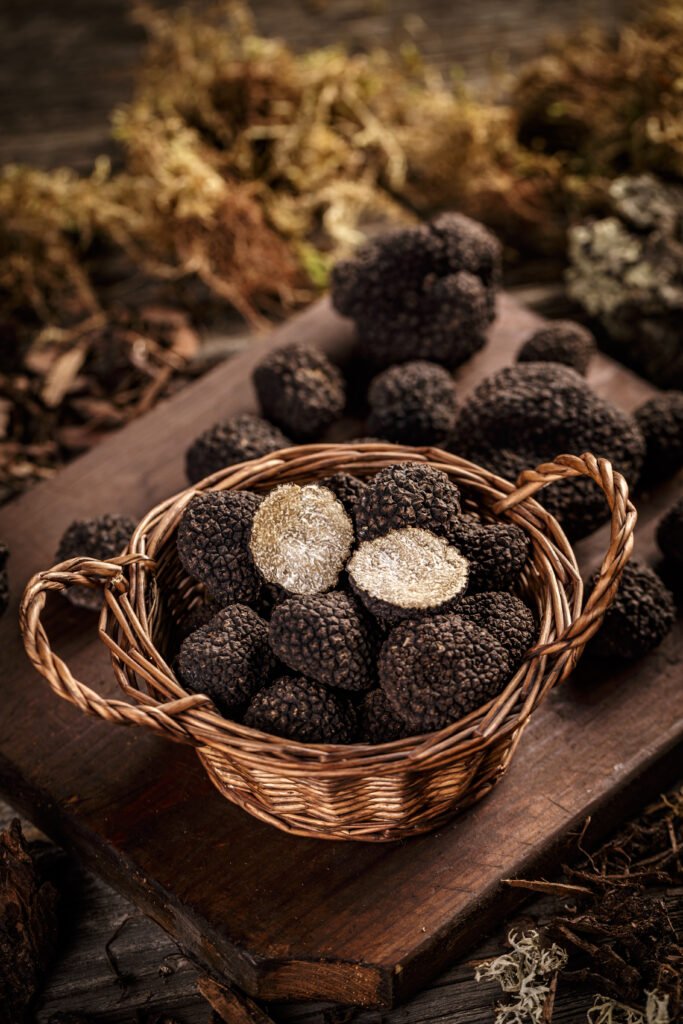
The Diamond Chocolate Factory: Heritage in Every Bite
At the Diamond Chocolate Factory, Grenada’s volcanic soil gives cocoa a floral taste. Their dark chocolate bars mix bitterness with mango and tobacco notes. Grinding is done with stone mills, a tradition since the 1800s.
Hands-On Chocolate Making Workshops
At St. George’s House of Chocolate, you get hands-on to make pralines. Instructors teach about Grenadian cocoa’s unique flavors. Your workshop ends with tasting chili-infused discs. It shows that Grenada chocolate tours are more than just tours—they’re conversations with history.
Beyond Cocoa: Exploring Grenada’s Spice Plantations and Rum Distilleries
Walking through Grenadian spice plantations, the air is filled with the scent of nutmeg, cinnamon, and allspice. At the Gouyave Nutmeg Processing Station, each ripe fruits turn into the world’s finest spices. The split nutmeg shells shows the crimson mace clinging to seeds, each step a link to Grenada’s past.
Guides here explained how every kernel becomes a flavor essential in Grenadian kitchens. This tradition is as rich as the earth itself.
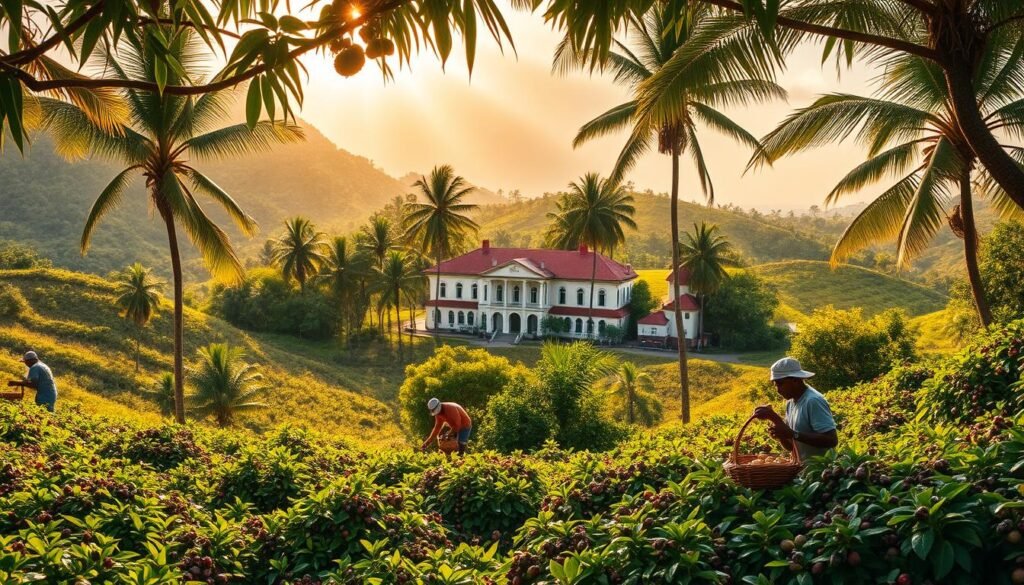
Your next stop is the River Antoine rum distillery, where copper stills whisper stories from 1785. This water-powered marvel produces fiery rum at 75% alcohol. Its steamy production floor is alive with molasses aromas.
Nearby, Westerhall Estate offers smoother aged rums, blending heritage with modern craftsmanship.
“Every drop tells a story of resilience,” said a distiller, tracing lines of cane juice to gold liquid treasure.
Between Grenada rum tours and nutmeg processing, these landscapes are more than sites—they’re living museums. At Laura Herb and Spice Garden, visitors learn how cloves and vanilla once traded as currency now inspire modern culinary artistry. Each visit supports communities keeping these traditions alive, inviting you to taste Grenada’s spice-isle soul.
Grenadian Signature Dishes Every Foodie Must Try
Grenada’s culinary soul is best seen in its signature dishes. These dishes tell the island’s history and show its hospitality. Start your journey in a sunlit kitchen where a local grandmother teaches you the Oil Down recipe. This dish is a mix of breadfruit, callaloo, and coconut milk, creating comfort food that shows resilience and unity.
Oil Down: A One-Pot Tapestry of Taste
The Oil Down recipe is more than food—it’s a story of Caribbean migration and survival. You learn to layer ingredients slowly, watching as the pot’s gentle churn told stories of spice traders and sugarcane fields. Every spoonful is a taste of Grenada’s heritage, best enjoyed at village festivals where families share stories over steaming bowls.
Conch Dishes Grenada: Ocean’s Bounty, Sustainably Sourced
At Grand Anse’s morning markets, fisherfolk bring in conch dishes Grenada treasures. Try the tangy ceviche at a beach shack run by a third-generation fisherman, who talks about his crew’s rotational harvesting. Curried conch at True Blue Bay Resort and crispy fried conch at street stalls show the versatility of this briny delicacy.
Nutmeg’s Sweet and Savory Dance
Nutmeg is more than a sprinkle—it’s a star. At Belmont Estate, have a taste of the nutmeg-enhanced stews and sauces that balanced earthiness with brightness. Desserts like nutmeg ice cream at True Blue Bay’s café or nutmeg-spiced cassava pudding in Speightstown markets show this spice’s versatility.
Ending with Grenadian Desserts
Try Grenadian desserts that linger: the nutmeg ice cream swirled with coconut, or honeyed plantain fritters at family-run Carbet Hotel. These sweets are more than treats—they’re bridges to island traditions, passed down through generations.
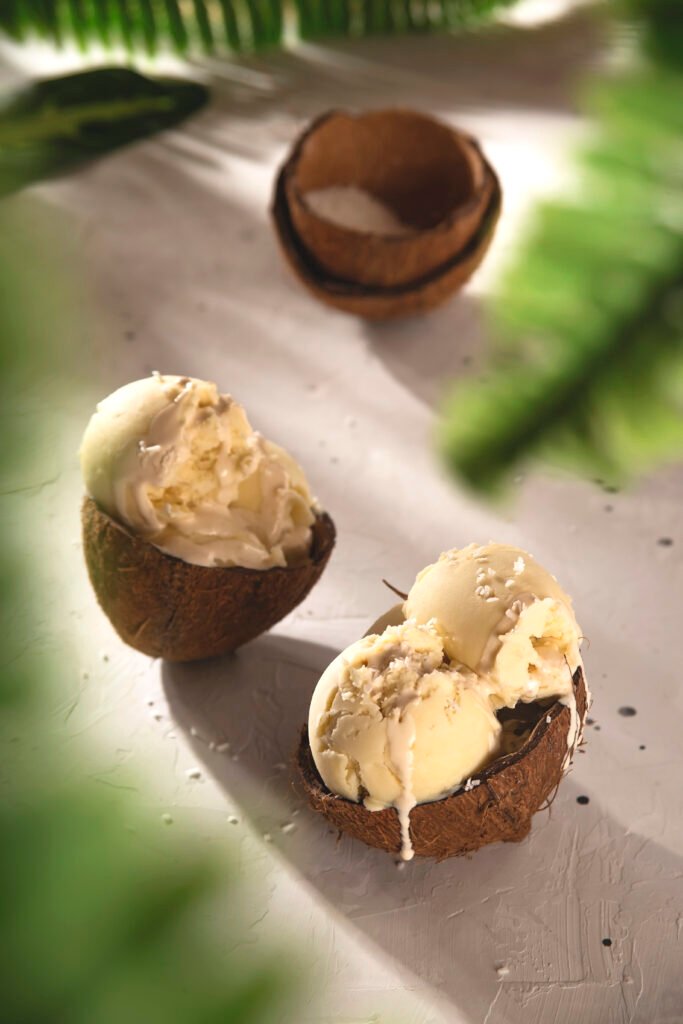
Cooking Classes and Food Workshops: Learning Grenadian Cuisine Firsthand
Get ready to dive into the world of Grenada cooking classes. Here, cast-iron pans sizzle and the scent of nutmeg fills the air. These sessions are more than just recipes; they’re a way to connect with the island’s heart.
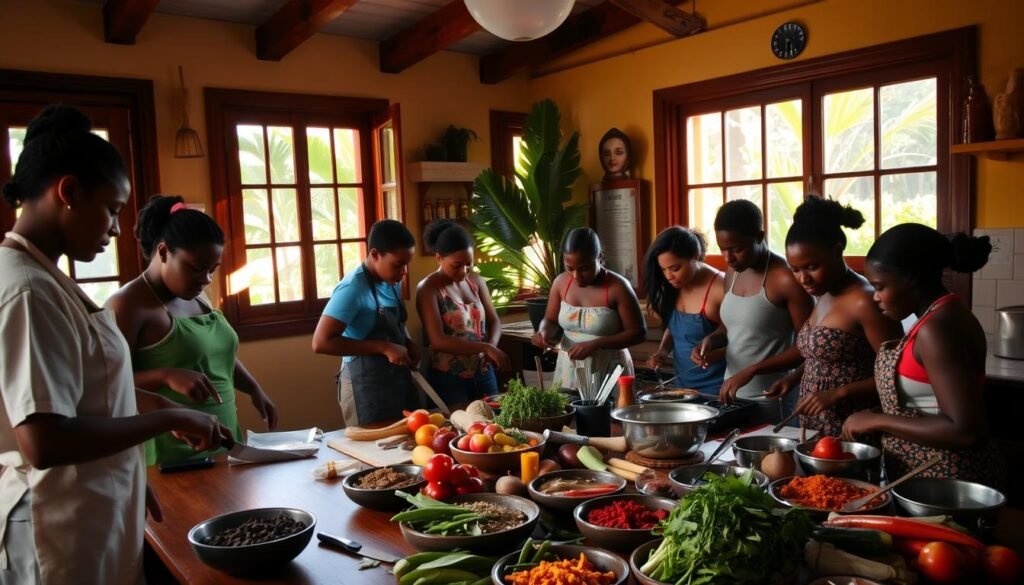
At places like Esther and Omega Cooking School in St. George’s, chefs teach you to make dishes such as callaloo soup and crab backs. You’ll learn how to mix fiery scotch bonnet peppers with coconut milk’s creaminess under bamboo roofs. Local culinary partners like this school provide everything you need, from ingredients to aprons.
Top Cooking Schools in Grenada
- Esther and Omega Cooking School: Specializes in spice-blending techniques
- Carriacou Culinary Collective: Focuses on lesser-known regional recipes
Family-Hosted Cooking Experiences
In Gouyave’s fishing communities, cooking with families is a unique experience. You’ll sit at wooden tables with fresh fish and breadfruit. One host said,
“Every pot here tells a story of migration and harvest cycles,”
as you prepared forOil Down. These sessions start early, with visits to the market for the freshest ingredients.
What to Expect in a Typical Class
Grenadian cuisine workshops usually last 3-4 hours. They start with tours of spice gardens. You’ll make provision dumplings and chili pepper sauce from scratch. After cooking, you’ll enjoy a family-style meal with local rum punches. Prices are $60–$120 USD, and they can accommodate gluten-free diets.
The Best Restaurants in Grenada: From Street Food to Fine Dining
As you journey through Grenada’s food scene, you get to know places where every bite has a story. For Grenadian street food, try the roti carts at Grand Anse. They serve curried chickpeas or goat in flaky layers. Near St. George’s University, you’ll also find vendors with warm doubles for those who love spice. These simple stalls are as good as the best Grenada restaurants in taste.
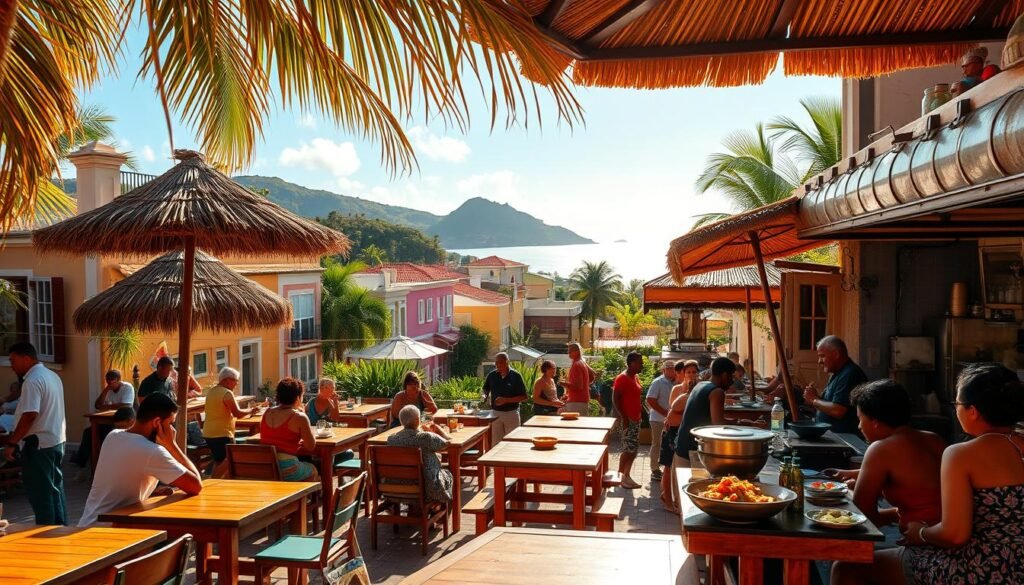
In St. George’s, BB’s Crabback is all about real flavors. Chef Brian Benjamin’s crabback dish is a mix of brine and heat. Nearby, authentic Caribbean restaurants Grenada like Lezay’s serve nutmeg-kissed stews in lively spots that feel like community centers.
For fine dining St. George’s, Rhodes Restaurant at the Calabash uses island ingredients in a fancy way. Their lobster thermidor, with sunset views, celebrates Grenada’s food. The Beach Club at Calabash offers light, beachy dishes like mahi-mahi tacos with coconut rice.
Don’t miss Fish Friday in Gouyave, where the streets turn into a Grenadian street food party. Whether at a simple cart or a fancy restaurant, Grenada’s food scene is all about tradition and new ideas.
Bringing Grenada Home: Spices, Chocolate, and Souvenirs for Your Kitchen
When you return home with Grenada’s flavors, you must follow customs rules carefully. On your first trip, you may forget to pick up a jar of nutmeg syrup. Luckily, vendors are available to help with the right packaging. Follow these tips to make your souvenirs last as culinary memories.
What’s Allowed: Navigating Grenada Food Imports
Bringing back most Grenadian spice, souvenirs and sealed chocolate from Grenada are okay. But, you must declare fresh jams, honey, or coffee beans at customs. Vanilla beans in airtight containers are also fine. Stay away from fresh herbs or meat products; choose dried or processed ones instead.
Always check USDA and FDA guidelines for Grenada food imports. This way, you can avoid any surprises.
Where to Shop: Curating the Best Flavors
- Spice Market Cooperative: Buy nutmeg, mace, and cinnamon in resealable tins ($8–$20). Great for long-distance travel.
- The House of Chocolate: Choose dark chocolate bars (70% cocoa) or chili-infused truffles ($15–$30 per box).
- Arawak Islands: Stock up on nutmeg syrup and allspice flakes. Look for labels with the producer’s name for authenticity.
Cooking with Grenada’s Gifts
Turn your kitchen into a tropical paradise. Use mace in spiced ciders or nutmeg in slow-cooked stews. One favorite tip is blending island-grown peppers into a hot sauce base. Add lime and local allspice for a burst of flavor.
These cooking with Grenadian spices tips will make your souvenirs a part of your daily cooking. This way, you can keep Grenada’s warmth close to your heart even after you return.
Sustainable Food Tourism: Supporting Local Communities Through Culinary Travel
Visiting Grenada’s kitchens and plantations is a story about care for each other. At the Grenada Chocolate Company, you’ll see numerous solar panels powering chocolate making. Farmers got fair pay, showing how tourism supports both taste and tradition. Support local food producers Grenada by picking tours like the St. Patrick’s Agri-Tourism Project. There, farm-to-table meals help fund youth farming workshops.
“When tourists taste our nutmeg-infused bread, they’re tasting 300 years of farming wisdom,” said farmer Emmanuel at a village market.
Here’s how to travel with purpose:
- Shop at St. George’s Market—80% of vendors reinvest profits into community gardens
- Book ethical culinary travel operators like Spice Island Chocolate Trail, certified for zero-waste practices
- Visit the Grenada Cacao Festival, where 50% of ticket fees go to Grenada community tourism programs
Choosing locally sourced lunches at La Plancha or sipping cocoa at Mount Carmel Spice Farm helps these networks. By choosing sustainable food tourism, you help keep Grenada’s culinary traditions alive. Every choice, from a nutmeg harvest tour to a rum distillery visit, connects you to the island’s heart and supports its future.
Conclusion: Creating Your Personalized Grenadian Culinary Adventure
When planning a Grenada food tour, finding the right mix of structure and spontaneity is key. Cruise passengers might start at St. George’s Market, where the scent of spices teaches you about Grenada’s food. A visit to a cocoa plantation shows how chocolate is made, a unique part of the Caribbean food scene.
Food lovers with a week to spend can explore more. They can follow nutmeg trails, learn cooking from locals, or discover how rum is made. This lets them dive deep into Grenada’s flavors.
Don’t forget to leave room for surprises. A chance encounter with a vendor or a fresh catch from a fisherman can make your trip unforgettable. Epicurean-Escape’s services can help plan your trip, ensuring you experience Grenada’s true spirit.
Grenada’s food is a way to connect with its culture. Every spice and dish tells a story of hard work and creativity. By exploring Grenada’s food scene, you get to taste its soul. Whether it’s street food or cocoa, this adventure lets you be a part of Grenada’s rich heritage.


